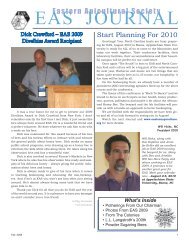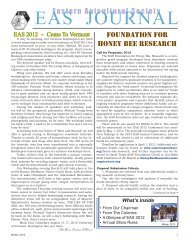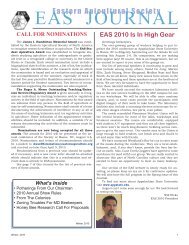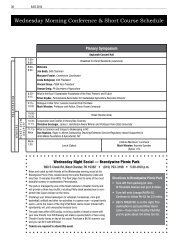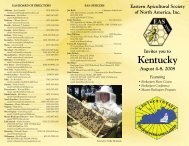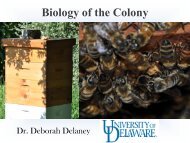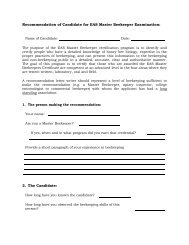Potherings From Our Chairman . . .The <strong>2008</strong> new year has arrived andit seems only yesterday that we celebratedthe change <strong>of</strong> the millennium.The first national bee event this yearwas the combined <strong>America</strong>n Bee Federation(ABF) and <strong>America</strong>n Honey ProducersAssociation (AHPA) meeting inSacramento, California. I was inspiredby a sideliner session by Kim Flottumon his predictions on the future <strong>of</strong>beekeeping. I think it is important totake a moment to survey the past yearand divine the future.Africanized Honey Bees – At thistime last year, the main fear <strong>of</strong> manystates was the arrival <strong>of</strong> Africanizedhoney bees (AHB) from Florida. Ithought that it was only a matter <strong>of</strong>time before a hive <strong>of</strong> AHB would eitherhitchhike or swarm from a truck <strong>of</strong>migratory hives. The worst case scenariois that the colony would attackor kill a person or confined pet provokinga backlash against bees andbeekeeping. And what if AHB coloniesbecame established in the area? I certainlywould no longer be able to keepcolonies in public parks and other suburbanlocations.Colony Collapse Disorder – Althoughthe AHB scenario can still happen,I would never have guessed thatan even graver scenario was threateningthe beekeeping community –Colony Collapse Disorder (CCD). Atthe ABF/AHPA conference, there weremany workshops featuring CCD. Thebeekeeping community seems dividedamong the usual suspects: pesticides,Nosema ceranae, Israeli Acute ParalysisVirus (IAPV), Varroa mites, nutrition,and bad beekeeping. There areeven a number <strong>of</strong> respectable researchersthat either deny that CCD existsor explain it away as a cyclical eventthat has happened many times in thepast. I can tell you one thing for certain– something is affecting the health<strong>of</strong> our bees. Last May, a survey <strong>of</strong> beekeepersin Pennsylvania revealed astate-wide loss <strong>of</strong> 49% <strong>of</strong> the hivesover the winter. Surely some <strong>of</strong> thelosses could be blamed on a brutallycold February but can you imagine a49% loss in the chicken or dairy industry<strong>of</strong> a state?So, what should we do differentlythis year? The suggestions thus farhave not changed since March 1, 2007;namely, treat with Fumigillan, do notput deadout colonies on top <strong>of</strong> healthycolonies, and treat with Terramycin,Apiguard, Apilife VAR, or MiteAway II,rather than “hard” chemicals.EAS responds to CCD• EAS has contributed researchmoney to the CCD Working Groupin 2007. Requests for research proposalshave already been distributedfor <strong>2008</strong>.• The EAS board provides a forumfor multistate and regionaldiscussions. Since irradiation <strong>of</strong>hive bodies has been shown to kill<strong>America</strong>n Foul Brood spores andlessen the infection <strong>of</strong> CCD, perhapsregional facilities can befound to sanitize old or deadoutequipment. Contact your EAS directorif you are interested in thisproject.• EAS conventions provide avenue to present research. Theconferences are large enough toattract top researchers yet intimateenough to meet and discusstopics with presenters.What <strong>of</strong> the future? CCD hascreated a great interest in bees andbeekeeping from the press and thegeneral public; most people now understandthe importance <strong>of</strong> honey beesto the food supply.• I predict there will be an increasednumber <strong>of</strong> new beekeepersthe next few years.• It is my hope that townshipswill consider the importance <strong>of</strong>bees before enacting restrictivebeekeeping ordinances.• More research will be done onall aspects <strong>of</strong> beekeeping.• EAS conventions will featuremany <strong>of</strong> the CCD researchers andbring you up-to-date on the latestCCD facts and theories.What <strong>of</strong> the future EAS conventions…EAS <strong>2008</strong> in Murray, Kentucky onAugust 4-8, <strong>2008</strong> promises to be a greatvenue. The registration area, dormitory,cafeteria, and meeting rooms areall in close proximity. Kent Williamsand Phil Craft have already assembledan exciting program.EAS 2009 Mark your calendar nowfor Ellicottville, New York, August 3-9, 2009. Bee Culture will sponsor theevent at Holiday Valley ConferenceContinued on Page 7EAS JournalJournal <strong>of</strong> the <strong>Eastern</strong> <strong>Apicultural</strong><strong>Society</strong> <strong>of</strong> <strong>North</strong> <strong>America</strong>, Inc.Volume 36, Number 1Jim BobbChairman <strong>of</strong> the Board2011 Shearer RoadLansdale, PA 19446610.584.6778chairman@easternapiculture.orgJimBobb@GCT21.netKathy SummersVice Chairman <strong>of</strong> the Board7011 Spieth RoadMedina, OH 44256330.461.1081 (cell)330.725.6677, Ext. 3215330.725.5624 (fax)vicechairman@easternapiculture.orgKent Williams<strong>2008</strong> President580 State Route 385 <strong>North</strong>Wingo, KY 42088-8703270.382.2348president@easternapiculture.orgBen Bauer2007 PresidentFirethorne Farm1020 Wylie RoadWest Chester, PA 19382610.793.9588president@easternapiculture.orgLoretta SurprenantSecretaryBox 300, 27 County Home WayEssex, NY 12936518.963.7593 (phone & fax)secretary@easternapiculture.orgJohn TullochTreasurerP.O. Box 473211 High StreetOdessa, DE 19730302.378.1917 (phone & fax)treasurer@easternapiculture.org2 <strong>Winter</strong>, <strong>2008</strong>
<strong>Winter</strong>, <strong>2008</strong>EAS Foundation for Honey Bee ResearchCall for Proposals, <strong>2008</strong>The EAS Foundation for Honey BeeResearch is a competitive grant programdeveloped from donations received frombeekeepers and others interested infunding research on topical problemsin honey bees. Proposals are solicitedannually with award amounts to bedetermined the spring before the EASannual meeting. Requests for supportfor student projects (undergraduatesummer employees/graduate student)or for equipment/supplies for distinctresearch projects are given highest priority.Requests for “seed money” to provideinvestigators the opportunity tocollect preliminary data or as “add on”funds to combine with other fundingsources to continue present researchwill also be considered. We welcomeseparate discreet project proposals andrequests that identify pieces <strong>of</strong> ongoingresearch programs where additionalfunds can accomplish an objective <strong>of</strong> alarger program. Grant funds may beused for supplies, equipment, salaries,travel or other appropriate uses by therecipient.There will be one award for $5000in <strong>2008</strong>. The award will be announcedat the EAS <strong>2008</strong> Conference but availableby May 1, <strong>2008</strong>. We intend to publicizethe award to aid in solicitation <strong>of</strong>additional funds for subsequent years.DEADLINE for application is APRIL1, <strong>2008</strong>.Proposal Submission Criteria1. Proposals are welcome from anyindividuals conducting research onhoney bees. The role the investigatorwill perform if awarded thefunds should be clearly stated.2. Proposal should briefly outline theobjective and a plan <strong>of</strong> work, to becompleted within 1 year <strong>of</strong> funding,and a justification for the proposedwork. If intended as “seed money,”the proposal should clearly statehow the funds will enable the investigatorto secure additionalfunding for project continuation.Proposals should not exceed fivewritten pages in total length(double-spaced) excluding titlepage, budget and resumes. Onlyelectronic submissions will be accepted.3. Proposal must indicate how resultswill be disseminated if grant isfunded. Investigators are encour-aged to present their work to a futureEAS annual meeting andthrough the EAS journal (in summaryform) if at all possible butother funds should be used forsuch dissemination. An acknowledgment<strong>of</strong> EAS support should beincluded in any presentations orpublications resulting from the research.4. The proposal should be arranged inthe following format:a) cover page to include title,name, address, email & telephone<strong>of</strong> investigators(s) andtitle/affiliation <strong>of</strong> investigatorb) justificationc) objective(s)d) project descriptione) plan <strong>of</strong> work/timetablef) budgetg) short (half page) resume <strong>of</strong>each participanth) name <strong>of</strong> principle investigatorto appear on every page <strong>of</strong> proposal(very important)5. Electornic copy <strong>of</strong> the proposalshould be submitted by APRIL1,<strong>2008</strong> to EAS Foundation for HoneyBee Research c/o EAS ChairmanJim Bobb, 2011 Shearer Road,Lansdale, A 19446, sent as attachmentto email atChairman@easternapiculture.orgProposal Review ProcessEAS will review each proposal witha three person proposal review board.One member is an elected Director tothe Board while the remaining two areresearchers (the Board member may bea researcher). None <strong>of</strong> the panel willhave a direct connection to any researchproject for which a proposal hasbeen submitted. In cases <strong>of</strong> conflictthat panel member will be excused fromvoting. Evaluation <strong>of</strong> proposals will bemade on the following criteria: Scientificmerit, relevance <strong>of</strong> the proposedproject to beekeeping, reasonableness<strong>of</strong> the budget proposal to the actualwork to be performed, potential for securingor adding to funding from othersources, and finally, interest <strong>of</strong> proposedresearch to EAS members. Allfunds must be expended by June 30,2009 and an accounting <strong>of</strong> expendituresmade available to the EAS treasurer byAug. 1, <strong>2008</strong>.From Indiana Up withYoung Beekeepers!…Alex Lesniak, a South Bend highschool sophomore, is Indiana’s 2007Young Beekeeper <strong>of</strong> the Year and winner<strong>of</strong> a $2,000 U.S. Savings Bond thatgoes with the honor. She is one <strong>of</strong>more than 20 young beekeepers whohave been recognized by the IndianaBeekeepers Association (IBA) over thepast nine years.Recognizing the need to stimulateinterest in and award outstandingachievements in beekeeping amongyoung people, the IBA unanimouslyapproved the Young Beekeeper Programat its board meeting in 1998, the IBA’sfirst year <strong>of</strong> existence. The IBA madeits first award in 1999.Gender-blind, the program is opento young beekeepers state wide. Thenine winners thus far number fourgirls, including Alex, and five boys. TheIBA’s newsletter has kept track <strong>of</strong> previouswinners each fall by running areport <strong>of</strong>, “Where Are They Now,” plottingeducational and other achievementsas they develop.This year, the three finalists (allreceived U.S. Savings Bonds, secondand third place receiving lesser denominations)composed an essay onhow beekeeping has affected theirlives, community, family and environment.They also explained the positivevalues they have gained from beekeeping,and their future plans. AtIBA’s fall meeting the three winnerstook part in a breakout session designedto let other members get toknow them better. Under the guidance<strong>of</strong> newly appointed co-ordinator LisaYowell, the Program attracted a record11 candidates in 2007.For more information aboutIndiana’s Young Beekeeper Program,contact Lisa Yowell atyowell13@isp.com.Please check yourmailing label on thisissue <strong>of</strong> the Journal. Ifyour name is misspelledor there needs to becorrections to youraddress, please let theEditor know.3



